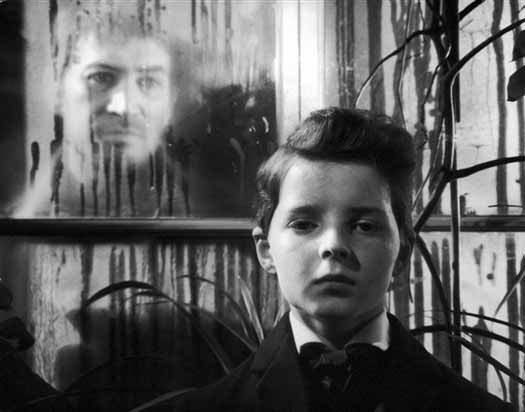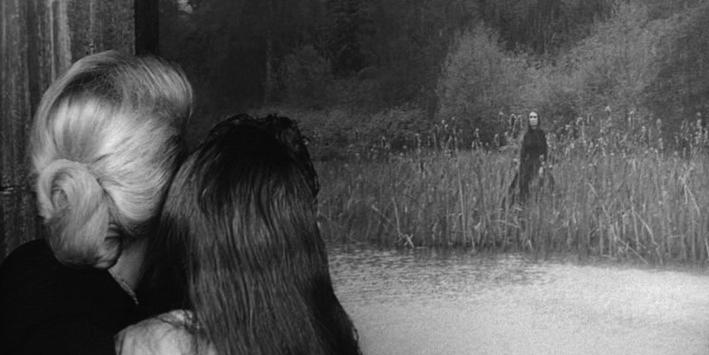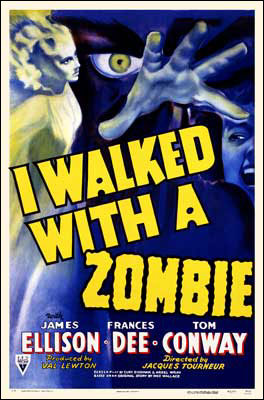 I WALKED WITH A ZOMBIE is one of those miraculous little films (a bare 69 minutes) that exists almost as much in the mind of the viewer as on the screen. Its story is actually relatively simple, but its treatment is sophisticated, creating an engaging, mature drama that hypnotically draws the audience into its shadowy world. But the simplicity of that world is deceptive, filled with contradictions and phenomenon that can never quite be explained to a certainty. Both science and superstition offer interpretations, and characters who adopt one or the other viewpoint believe they have understanding, but the film refuses to elevate one worldview over the other, inviting the audience to adopt an open-minded sense of wonder in which both are possible. The result could have been frustrating, even foolish. But I WALKED WITH A ZOMBIE presents its mysteries with a shimmering beauty rarely seen in a horror film. There is no crude horror, no blatant shocks; Continue reading “I Walked with a Zombie (1943) – DVD Review”
I WALKED WITH A ZOMBIE is one of those miraculous little films (a bare 69 minutes) that exists almost as much in the mind of the viewer as on the screen. Its story is actually relatively simple, but its treatment is sophisticated, creating an engaging, mature drama that hypnotically draws the audience into its shadowy world. But the simplicity of that world is deceptive, filled with contradictions and phenomenon that can never quite be explained to a certainty. Both science and superstition offer interpretations, and characters who adopt one or the other viewpoint believe they have understanding, but the film refuses to elevate one worldview over the other, inviting the audience to adopt an open-minded sense of wonder in which both are possible. The result could have been frustrating, even foolish. But I WALKED WITH A ZOMBIE presents its mysteries with a shimmering beauty rarely seen in a horror film. There is no crude horror, no blatant shocks; Continue reading “I Walked with a Zombie (1943) – DVD Review”
Tag: greatest horror films of all time
Ju-on, The Grudge (2003) – Film & DVD Review
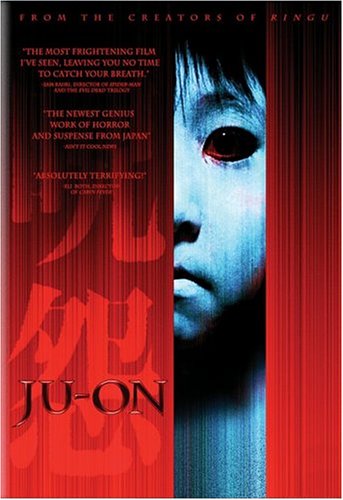 Recall your worst nightmares as a child: your fear of the dark, of being alone in bed at night, of shadows without substance lurking in corners, beneath the bed, outside your door, or in your closet. Remember the creaking floorboards, the rustle of wind or the moan of some animal – a cat, perhaps? – which led you to believe that you were no longer alone, that something tangible was there with you, about to manifest itself before your frightened senses. Now imagine this fear captured on celluloid and presented to you with all the evocative power of your childhood nightmares – only now the nightmare seems utterly convincing, because you know you are awake, and utterly inescapable, because it can follow you anywhere: in attics, down stairs, along corridors, through doors, even into that one place you felt absolutely safe as a child – beneath the bed covers. This is the essence of horror captured in JU-ON: THE GRUDGE, Continue reading “Ju-on, The Grudge (2003) – Film & DVD Review”
Recall your worst nightmares as a child: your fear of the dark, of being alone in bed at night, of shadows without substance lurking in corners, beneath the bed, outside your door, or in your closet. Remember the creaking floorboards, the rustle of wind or the moan of some animal – a cat, perhaps? – which led you to believe that you were no longer alone, that something tangible was there with you, about to manifest itself before your frightened senses. Now imagine this fear captured on celluloid and presented to you with all the evocative power of your childhood nightmares – only now the nightmare seems utterly convincing, because you know you are awake, and utterly inescapable, because it can follow you anywhere: in attics, down stairs, along corridors, through doors, even into that one place you felt absolutely safe as a child – beneath the bed covers. This is the essence of horror captured in JU-ON: THE GRUDGE, Continue reading “Ju-on, The Grudge (2003) – Film & DVD Review”
Two Faces of Dr. Jekyll (1960) – Hammer Horror Review
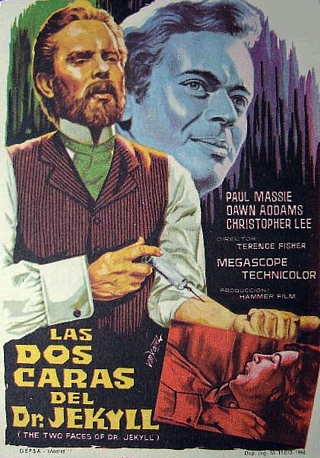 This imaginative and original take on the old Robert Louise Stevenson tale is one of the best and most underrated efforts from Hammer Films, the English company that had previously produced updated versions of Mary Shelly CURSE OF FRANKENSTEIN in 1957) and Bram Stoker (HORROR OF DRACULA in 1958). Bold and colorful, THE TWO FACES OF DR. JEKYLL (like Hammer’s version of THE PHANTOM OF THE OPERA, one year later) comes from an era when the company, having scored major box office success with horror, was pushing the boundaries of the genre, emphasizing the drama, characterization, and even philosophic undertones, wrapped up in lavish, widescreen production values that suggest an opulent costume drama rather than a tawdry terror show. Unfortunately, the film (like PHANTOM) was not a success, and subsequent Hammer horrors would retreat to more conventional territory.
This imaginative and original take on the old Robert Louise Stevenson tale is one of the best and most underrated efforts from Hammer Films, the English company that had previously produced updated versions of Mary Shelly CURSE OF FRANKENSTEIN in 1957) and Bram Stoker (HORROR OF DRACULA in 1958). Bold and colorful, THE TWO FACES OF DR. JEKYLL (like Hammer’s version of THE PHANTOM OF THE OPERA, one year later) comes from an era when the company, having scored major box office success with horror, was pushing the boundaries of the genre, emphasizing the drama, characterization, and even philosophic undertones, wrapped up in lavish, widescreen production values that suggest an opulent costume drama rather than a tawdry terror show. Unfortunately, the film (like PHANTOM) was not a success, and subsequent Hammer horrors would retreat to more conventional territory.
The screenplay by Wolf Mankowitz more or less turns Stevenson’s story “The Strange Case of Dr. Jekyll and Mr. Hyde” inside out. Dr. Jekyll (Paul Massie) here becomes a bearded, somewhat anti-social recluse, more at home in his lab than in his home, who (per Nietzsche) dreams of going beyond Good and Evil, not of separating the two. When he transforms it is not into a misshapen monster or a Darwinian throwback (as in the 1932 version with Frederick March) but into a dapper, handsome devil, eager to enjoy all the delights the seedier side of London has to offer. This is a decidedly amoral (as opposed to immoral) Hyde, only interested (at least initially) in the pursuit of pleasure; there is almost a touch of Oscar Wilde about him – which should not be a big surprise, since screenwriters have been using Wilde’s The Picture of Dorian Gray to pad out the details of Stevenson’s slim story at least since the 1920 silent DR. JEKYL AND MR HYDE with John Barrymore.
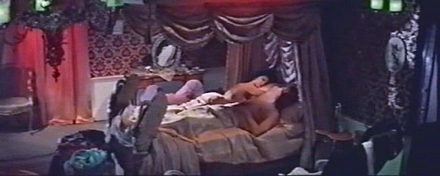 After seducing a lady snake charmer, Hyde soon grows bored with conventional debauchery, but in the meantime he has learned that Jekyll’s best friend Paul (Christopher Lee) is having an affair with Jekyll’s flirtatious wife Kitty (Dawn Addams), so he sets his sights on her. When neither seduction nor bribery works, he resorts to rape and murder, then frames Jekyll for the crimes. However, after an inquest clears Hyde, Jekyll reasserts himself, transforming in front of the police, who arrest (and presumably go on to try and convict) him for the murders, insuring that Hyde will never be unleashed again.
After seducing a lady snake charmer, Hyde soon grows bored with conventional debauchery, but in the meantime he has learned that Jekyll’s best friend Paul (Christopher Lee) is having an affair with Jekyll’s flirtatious wife Kitty (Dawn Addams), so he sets his sights on her. When neither seduction nor bribery works, he resorts to rape and murder, then frames Jekyll for the crimes. However, after an inquest clears Hyde, Jekyll reasserts himself, transforming in front of the police, who arrest (and presumably go on to try and convict) him for the murders, insuring that Hyde will never be unleashed again.
Hammer horror owed much of its success to brilliant color photography (often by Jack Asher), lavish production design (usually by Bernard Robinson), and clever casting (often with Peter Cushing and/or Christopher Lee), but their best efforts featured solid scripting as well (often by Jimmy Sangster). This is nowhere more true than in TWO FACES OF DR. JEKYLL, which features probably the best screenplay of any Hammer film, written by Wolf Mankowitz (a successful playwright who also co-scripted Val Guests DAY THE WORLD CAUGHT FIRE). The film is filled with witty dialogue and clever characterization that breaks down the usual Good-Evil dichotomy seen in most Hammer movies, which often resembled fairy tales scripted for adults.
To some extent, Jekyll is an unsympathetic personality who (we can infer) drove his wife into an affair because of his inattention to her. Kitty may not be a faithful wife, but she genuinely loves Paul and wants to end the hypocrisy of her marriage; she also has the good sense to find Edward Hyde completely repulsive. Paul is somewhat of a rogue and a scoundrel, but he is also guilt-ridden and remorseful over his betrayal of his friend; he’s just too weak to terminate the love triangle by taking Kitty away from Jekyll. As for Hyde, as the film’s title implies, he really is Jekyll’s alter ego; much of what he does (such as the revenge against Paul and Kitty) makes sense only if we understand that he is simply acting out Jekyll’s repressed impulses – impulses that Jekyll knowingly and deliberately unleashed with his experiments. The result is a highly charged drama, punctuated with mere moments of horror, that plays out like a tragedy, leading to the inevitable moment when Jekyll publicly reveals himself as the man behind the monster.
Director Terence Fisher seizes upon the opportunities in the script, to brilliant effect. Fisher always seemed more interested in the emotional underpinnings of his Gothic films than in the mechanics of suspense: his horror scenes were seldom of the Hitchcockian variety, using multiple camera angles and editing to build tension; instead, he preferred long takes in which the movements of the actors, complimented by subtle movements of the camera, created the dynamic. Shot in widescreen, TWO FACES OF DR. JEKYLL offers a perfect showcase for this directorial approach, providing a large canvas on which Fisher can project all the gaudy elements at his disposal, which fill the frame like a colorful pageant.
Fisher mostly eschews traditional horror elements in favor of emphasizing the moral horror of a conscienceless hedonist completely indifferent to the suffering he inflicts on others. The formerly de rigueur transformation from Jekyll to Hyde is never explicitly shown, taking place mostly off-camera; the only horror comes from Jekyll’s increasing helplessness at stopping the process. Fisher also plays clever little games to underline Mankowitz’s point about hypocritical Victorian distinctions between respectable and non-respectable society. He conveys a certain lusty glory while indulging in depictions of the less respectable entertainments available in London. The film is filled with colorfully costumed extras, including numerous dancing girls in flowery skirts, all captured in an enticing fashion that makes them seem vibrant and exciting. Again, this seems to be a deliberate attempt to undermine Stevenson’s story, wherein Hyde’s Soho shenanigans (implied but not detailed) were clearly meant to symbolize nothing but sin and degradation.
Perhaps the highlight of this approach is the snake charmer’s dance. In an era when explicit depictions of sexuality were not allowed, Fisher managed to give this sequence, laden with innuendo, a galvanic charge as powerful as anything seen in later, more permissive eras. The erotic gyrations, accompanied by exotic music (composed by David Heneker and Monty Norman, the later the creator of the famous James Bond theme) are at once tawdry and refined, sophisticated and suggestive, culminating in a climax wherein the dancer actually takes the constrictor’s phallic head into her mouth (a trick Alice Cooper would adopt in his demented stage show over a decade later)!
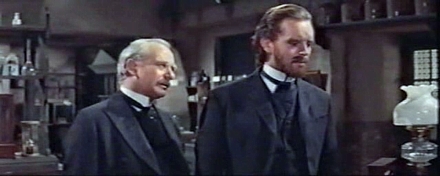 The performances are first-rate. David Kossoff is sincere and touching as Dr. Ernst Littauer, an old colleague who warns Jekyll against his experiments and later laments his downfall. Dawn Addams is sharp and seductive as Kitty. Paul Massie does an excellent job in the dual role, capturing the stolid Jekyll with a low voice (aided by a beard and contact lenses to hide his good looks), then bursting forth with vibrancy and gusto as the unleashed Hyde. As the film goes on, his acting strategy becomes perhaps a bit transparent (Jekyll’s strained voice starts to sound artificial), but in the end Massie nonetheless emerges triumphant as the actor who has done perhaps the best job of blurring the lines between Jekyll and Hyde.
The performances are first-rate. David Kossoff is sincere and touching as Dr. Ernst Littauer, an old colleague who warns Jekyll against his experiments and later laments his downfall. Dawn Addams is sharp and seductive as Kitty. Paul Massie does an excellent job in the dual role, capturing the stolid Jekyll with a low voice (aided by a beard and contact lenses to hide his good looks), then bursting forth with vibrancy and gusto as the unleashed Hyde. As the film goes on, his acting strategy becomes perhaps a bit transparent (Jekyll’s strained voice starts to sound artificial), but in the end Massie nonetheless emerges triumphant as the actor who has done perhaps the best job of blurring the lines between Jekyll and Hyde.
But the true scene-stealer here is Lee as Jekyll’s faithless friend, Paul, whose function in the film is to act as a sort of yardstick for Hyde’s debauchery. Paul initially seems like a hopeless reprobate, but his moral failings pale to insignificance when placed against Hyde’s – Lee perfectly captures the sudden sense of moral indignation when Hyde offers to pay off his gambling debts in exchange for an opportunity to sleep with Kitty. Lee was most often give roles (like Dracula) that emphasized his height and his screen presence, often using him more like a prop than an actor, but here he gets to convey a wide range of emotions (love, laughter, lust, and more), ultimately making Paul a sympathetic if fatally flawed human being. This is the one role, perhaps more than any other, that shows Lee capable of giving a genuine character performance, as opposed to being a horror star or a heavy.
When the movie flopped during its initial release, Hammer tried retitling it as “Jekyll’s Inferno” and “House of Fright,” but for some reason the movie never caught on. Perhaps it was too clever, and audiences could not accept the portrayal of a dashing young handsome Hyde (even though this approach was perfectly in line with Hammer’s other success stories, such as turning Lee’s Count Dracula into a seductive sexual predator). In any case, THE TWO FACES OF DR. JEKYLL faded from screens and memories, never attaining the cult-classic status of Hammer’s Dracula and Frankenstein films. This is unfortunate, as the film at least equals those previous efforts in production value – and exceeds them in its screenplay. This is a masterpiece in its own right – and not merely a genre masterpiece. As a horror film, TWO FACES OF DR. JEKYLL barely ranks on the scare-meter; those looking for shocks and suspense had best seek them elsewhere. But as an exploration of two-faced hypocrisy and the mystery of identity, this ranks as one of the genre’s finest achievements.
TRIVIA
A few lines of dialogue have been looped in post-production, apparently in an attempt to please the censors. For example, when Hyde is confronted by a night club bouncer, he says, “Go to the Devil.” The audio recording quality is clearly different from the rest of the dialogue, and the words do not match the lip movements. (Presumably, he originally said, “Go to hell.”)
The film features a very young Oliver Reed as the night club bouncer who tries to shake down Edward Hyde for a little cash.
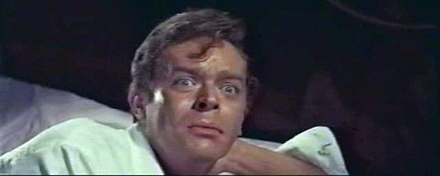
THE TWO FACES OF DR. JEKYLL(1960). Directed by Terence Fisher. Screenplay by Wolf Mankowitz, based on “The Strange Case of Dr. Jekyll and Mr. Hyde” by Robert Louis Stevenson. Cast: Paul Massie, Dawn Addams, Christopher Lee, David Kossoff, Francis De Wolff, Norma Marla, Magda Miller, Oliver Reed.
[serialposts]
The Innocents (1961) – Retrospective Review
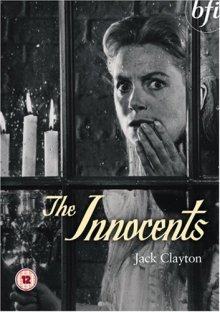 “Do They Ever Return to Possess the Living?”
“Do They Ever Return to Possess the Living?”
That was the question asked in the advertising for this adaptation of Henry James’ classic novelette, The Turn of the Screw.It is a question that goes unanswered by the film itself, which true to the source material leaves the existence of ghosts unclear, forcing audiences to debate whether Quint (Peter Wyngarde) and Miss Jessel (Clytie Jessop) are really visitors from the grave or simply figments of the demented imagination of governess Miss Giddens (Deborah Kerr). Imagine yourself as the young English governess, given sole responsibility for two young children growing up in an isolated country manor. Shortly after assuming this position (your first), you begin to see the ghosts of your unfortunate predecessor and her lover, a valet with an evil reputation. At first you seek to shield your young charges from the horror haunting the house, but soon you come to believe that your young charges are not only fully aware of the ghosts but actively in league with them. You cannot seek outside help without seeming mad, and your employer, the uncle of the orphaned children, wants under no circumstances to be bothered, leaving you to face the situation alone, and unguided. How can you stop the these visitors from the grave from claiming the “innocents” as their prey?
This unresolved mystery charges the events of THE INNOCENTS with a dreadful sense of uncertainty far more thrilling than the simple supernatural chills of a typical haunted house movie – another “turn of the screw,” as James would have said. At the same time, the ambiguous narrative serves up its share of suggestive shivers; its ghostly apparitions, achieved without special effects, convey a palpable sense of horror. Glimpsed at a distance or through windows, lurking in the shadows of night but sometimes revealing themselves by day, are utterly convincing and magnificently threatening without ever actually doing anything; their supernatural stillness, as much as anything else, sends shivers down the backbone, playing the vertebrae like a skeletal hand tapping on a xylophone.
Truman Capote`s screenplay plays upon the ambiguity of James` tale: are the two children really possessed by the ghosts of the dead, or is their governess merely imagining everything? Producer-director Jack Clayton keeps the film firmly grounded in reality, so that the intrusion of the supernatural strikes far more strongly.
The overt horror in THE INNOCENTS takes the form of Quint and Miss Jessel – tangible apparitions who appear as solid as a living beam, not like some gauzy ghost. Miss Jessel is the more reticent of the two, waling in the shadows at the end of a hallway, standing on the shore across a lake, or crying in a school room. Quint seems more aggressive. First glimpsed atop a tower, he is later seen peering through windows, his expressions paralleling those of Miles, as if the dead valet were the puppeteer pulling the strings of the young lad.
In way, however, the real horror of the film resides in the children. Are Miles and Flora innocent, or are they in league with the ghosts? Martin Stephens and Pamela Franklin are excellent, their too perfectly precocious innocence suggesting that Miss Giddens’ fears may have some basis in reality after all. Stephens is given more opportunity to shine, but Franklin (who would go on to star in 1974’s THE LEGEND OF HELL HOUSE) holds her own, delivering lovely lines of twisted dialogue such as “Oh, look – there’s a lovely spider, and it’s eating a butterfly!”
Deborah Kerr gives a superb performance, conveying Miss Giddens’ desperate desire to help while overtly suggesting a note of repressed hysteria, hinting that the ghosts may be externalizations of her own inner demons. Kerr brings this complex, redoubtable character to life in THE INNOCENTS with an added layer of her own. In the book, the governess was in her early twenties at most; her youth and inexperience could excuse this missteps she makes in her dire circumstances. Kerr, although youthful, was clearly older than the book’s character, yet she played the part with the naiveté of an inexperienced woman, while adding a range of affected mannerisms hinting at hidden neurosis. Consequently, she comes across as a spinster in the making, her repressed sexuality bubbling to the surface in her obvious attraction to her employer (whom she sees only once, during the job interview that opens the film) and in her reaction to learning that her predecessor engaged stormy nearly sado-masochistic relationship with the valet, a man clearly her social inferior (an unforgivable taboo for a Victorian woman).
Oscar-winner Freddie Francis delivers excellently black-and-white photography in beautiful widescreen Cinemascope. When Miss Giddens wanders the shadowy halls of Bly at night, candelabra in hand as she follows the whispered words of Quint and Jessel, the scene superficial resembles typical horror movie cliches, but it is handled with grand flair, including some clever camera effects to suggest that the moving candles truly are lighting the scene. In the days before film could rely on available light, Francis had special filters fashioned that created a spotlight-like effect, with the image bright in the center of the frame and tapering off to darkness toward the edges. The sequence is perhaps the closest the film comes to visualizing a cinematic equivalent of James’ prose, with the haunting effects serving equally well as evidence of the supernatural or the psychological.
Seen decades after its initial release, THE INNOCENTS is clearly a relic from a bygone era, before The Haunting (1963), The Legend of Hell House (1973), Poltergeist (1982), and the remake of The Haunting (1999) had moved the haunted house sub-genre toward ever more jarring effects. Yet THE INNOCENTS continues to trump all of their best efforts. As frightening as some of those films are, none of them sucker punch the audience with the devastating emotional wallop of Clayton’s masterpiece. The ending seems designed with almost deliberate sadism, building the climax to a breath-taking crescendo and then fading away to an eerie silence that perfectly captures the feel of the novel’s closing line: “We were alone with the quiet day, and his little heart, dispossessed, had stopped.”
DVD DETAILS
The 20th Century Fox DVD offers a two-sided disc, one with a widescreen transfer, the other with a full screen transfer. The audio is available in English stereo or Spanish mono, with options for English or Spanish subtitles. Bonus features (the same on both sides of the disc) are limited to the film’s theatrical trailer, plus some clips and recommendations for other Fox home video releases (LEGEND OF HELL HOUSE, PHANTOM OF THE PARADISE).
The film is divided into 28 chapters, with titles like “Tears of a Ghost.” The menu images culled from the black-and-white film have been colorized. Both transfers retain the photography’s beautiful contrast of light-and-shadow. The full screen version is not too bad an alternative if you do not have a widescreen television; much of it looks quite nice, but several shots do betray the loss of picture image around the sides. The widescreen transfer is of course preferable, preserving the widescreen compositions of the Cinemascope photography, particularly in shots like the one below, of Miss Giddens forcing Flora to confront the ghost of Miss Jessel (the two heads in the foreground, which are matted into the shot, not filmed live on location, are almost cropped off in the full screen version).
The trailer is a bit schizophrenic. It emphasizes THE INNOCENT’s serious approach to the ghost story, citing the resptable credits of Kerr and Clayton, but there seems to be a deliberate attempt to pump up the volume, including an echoing voice that asks the question quoted at the top of this review. The words are illustrated in eerie letters superimposed over a swirling, almost psychedelic vortex of black-and-white (an image not in the film, which was presumably achieved with paint in a tank). There is also an odd moment when the originally recorded soundtrack rather obviously drops out: the music and background effects disappear while the narrator reads the screenwriting credit for William Archibald and Truman Capote. (Presumably, the final screen credit changed, and the narration had to be re-recorded and awkwardly dropped in.)
Needless to say, this bare-bones presentation does not do justice to Jack Clayton’s classic.. One hopes that, someday, Fox will release a special edition disc loaded with bonus features.
THE INNOCENTS (1961). Produced and directed by Jack Clayton. Screenplay by William Archibald and Truman Capote, basedon the play by Archibald and the novel The Turn of the Screwby Henry James, additional scenes and dialgoue by John Mortimer. Cast: Deborah Kerr, Martin Stephens, Pamela Franklin, Megs Jenkins, Michael Redgrave, Peter Wyngarde, Clytie Jessop.
Top 20 Chick Flick Horror Movies
So, you’re a horror movie maniac. You just can’t get enough of ’em. You love the thrill of fear, the scream of terror, the sight of blood. But you have a problem: Your boxed set of BLIND DEAD movies does not enamor your girlfriend. Your Lucio Fulci collection does not send your paramour swooning with rapture. Your unrated torture porn DVDs do not arouse interest. The midnight movie screening of GRINDHOUSE does not inspire romantic fantasies. The latest French gore-fest does not excite erotic intrigue. If anything, the woman in your life is wondering whether you’re a latent serial killer whose interest in the female body does not extend beyond seeing it torn to pieces. You are faced with a dreadful dilemma: either continue to alienate your significant other or stuff those video nasties in the back of the closet along with the real pornography and suffer through endless nights of watching mind-numbingly boring chick flicks like BED OF ROSES (a fate that frightens you far more than anything in your horror collection). Well, lucky for you, we’re here to save the day. You see, there is a way to share your love of the horror genre with a psychologically stable female partner who is not interested in watching an endless stream of blood gushing across the screen. Believe it or not, there are “chick flick” horror movies. They may not be as intense and hardcore as some of your favorite splatter flicks, but they are quite good in their own right, with plenty of appeal to both men and women. Below, we will provide our list of the Top 20 Best Chick Flick Horror Movies.
NOTE: We have more or less listed the films in order of their female appeal, which means that the top-ranked films may not be the most frightening. The first ten tend to emphasize romantic elements of the sort that might be found in a mainstream “chick flick.” The remaining ten simply feature strong female leads.
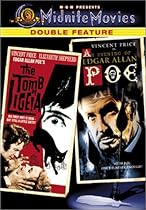 1. TOMB OF LIGEIA (1964). This adaptation of Edgar Alan Poe’s “Ligeia,” features Vincent Price as a man obsessed with the fear that his late wife will return from the grave to haunt him. Although technically too old for role, which was written as a young romantic lead, Price is wonderful as the doomed widower; with a little assist from the makeup department, he conveys the necessary mystique. Lady Rowena (Elizabeth Shepherd) meets and falls in love with him, inspiring him to overcome his fear and marry her. The story is told from Rowena’s point of view, as she is intrigued and enamored by this brooding, mysterious man, only to learn that the dark secret hanging over him will not easily be dispelled. Thanks to a strong performance by Shepherd, working from a great script by Robert Towne, Rowena emerges as one of cinema’s strongest leading ladies – willful and intelligent, she risks her life to drag her husband from the grip of the late Lady Ligeia. The horror element is very muted; the emphasis is on the doomed romance between the two lovers. A moody masterpiece, the film’s fear factor is mostly implied; director Roger Corman includes a few jump scares (the sudden snarl of a cat) and some hypnotic dream sequences, creating an almost surreal sense of dread the relies on Gothic atmopshere more than on-screen violence. In short, this Gothic Romance is the perfect date night rental: you can enjoy the “Gothic,” and she will enjoy the “Romance.”
1. TOMB OF LIGEIA (1964). This adaptation of Edgar Alan Poe’s “Ligeia,” features Vincent Price as a man obsessed with the fear that his late wife will return from the grave to haunt him. Although technically too old for role, which was written as a young romantic lead, Price is wonderful as the doomed widower; with a little assist from the makeup department, he conveys the necessary mystique. Lady Rowena (Elizabeth Shepherd) meets and falls in love with him, inspiring him to overcome his fear and marry her. The story is told from Rowena’s point of view, as she is intrigued and enamored by this brooding, mysterious man, only to learn that the dark secret hanging over him will not easily be dispelled. Thanks to a strong performance by Shepherd, working from a great script by Robert Towne, Rowena emerges as one of cinema’s strongest leading ladies – willful and intelligent, she risks her life to drag her husband from the grip of the late Lady Ligeia. The horror element is very muted; the emphasis is on the doomed romance between the two lovers. A moody masterpiece, the film’s fear factor is mostly implied; director Roger Corman includes a few jump scares (the sudden snarl of a cat) and some hypnotic dream sequences, creating an almost surreal sense of dread the relies on Gothic atmopshere more than on-screen violence. In short, this Gothic Romance is the perfect date night rental: you can enjoy the “Gothic,” and she will enjoy the “Romance.”
 2. I WALKED WITH A ZOMBIE (1943). Producer Val Lewton famously called this movie “Jane Eyre in the West Indies.” He may have been joking, but the statement was accurate enough in its way. The story follows a nurse named Betsy (Frances Dee) who gets a job on a plantation tending the brain-dead wife of her employer Paul (Tom Conway). The wife may or may not be a zombie (the film is deliberately ambiguous on this point); either way, her presence is a living a reminder of ugly family secrets that Paul would rather forget. Betsy falls in love with him, of course, but she sublimates her desire by trying to cure Paul’s wife, taking her to a voodoo ceremony. The attempt backfires: the locals are terrified of the zombie woman and want to destroy her. Atypically for the horror genre, the characterization and performances outweigh the horror; Director Jacques Tourner presents the horror almost entirely in terms of atmosphere, creating a dream-like world in which science and the supernatural vie for acceptance, but ultimately, the voodoo element is a backdrop for the love story between Betsy and Paul, with her in the Jane Ayre role and him as the Byronic Rochester substitute. Best of all, the lovers actually get together and (presumably) live happily ever after.
2. I WALKED WITH A ZOMBIE (1943). Producer Val Lewton famously called this movie “Jane Eyre in the West Indies.” He may have been joking, but the statement was accurate enough in its way. The story follows a nurse named Betsy (Frances Dee) who gets a job on a plantation tending the brain-dead wife of her employer Paul (Tom Conway). The wife may or may not be a zombie (the film is deliberately ambiguous on this point); either way, her presence is a living a reminder of ugly family secrets that Paul would rather forget. Betsy falls in love with him, of course, but she sublimates her desire by trying to cure Paul’s wife, taking her to a voodoo ceremony. The attempt backfires: the locals are terrified of the zombie woman and want to destroy her. Atypically for the horror genre, the characterization and performances outweigh the horror; Director Jacques Tourner presents the horror almost entirely in terms of atmosphere, creating a dream-like world in which science and the supernatural vie for acceptance, but ultimately, the voodoo element is a backdrop for the love story between Betsy and Paul, with her in the Jane Ayre role and him as the Byronic Rochester substitute. Best of all, the lovers actually get together and (presumably) live happily ever after.
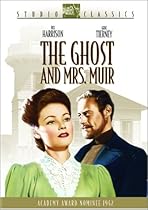 3. THE GHOST AND MRS MUIR (1947). This classic is much more romantic-comedy than horror, but the early scenes – when Mrs. Muir (Gene Tierney) moves into the old house and realizes it is haunted by the ghost of an old sea captain (Rex Harrison) are as effective as any genuine haunted-house movie. The ghost’s first appearance – a shadowy, out-of-focus silhouette – sends a shiver or two down the spine, and his later full-blown revelation -when Mrs. Muir lights and candle, revealing him standing next to her – is a genuine shock. After this, the film segues into a love story levened with humor, but Tierney and Harrison are absolutely wonderful, and the film will charm the woman in your life – and entertain you as well.
3. THE GHOST AND MRS MUIR (1947). This classic is much more romantic-comedy than horror, but the early scenes – when Mrs. Muir (Gene Tierney) moves into the old house and realizes it is haunted by the ghost of an old sea captain (Rex Harrison) are as effective as any genuine haunted-house movie. The ghost’s first appearance – a shadowy, out-of-focus silhouette – sends a shiver or two down the spine, and his later full-blown revelation -when Mrs. Muir lights and candle, revealing him standing next to her – is a genuine shock. After this, the film segues into a love story levened with humor, but Tierney and Harrison are absolutely wonderful, and the film will charm the woman in your life – and entertain you as well.
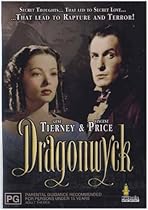 4. DRAGONWYCK (1946). This Gothic-Mystery-Romance features both Gene Tierney and Vincent Price; in many ways, it predates Price’s later TOMB OF LIGEIA, and it was filmed when he was still young enough to play a leading man. More important, this was before he had earned a reputation for screen villainy, so the horrible revelations about his character come as a complete surprise, instead of being telegraphed (as they are in LIGEIA). Price plays the wealthy Nicholas Van Ryn, who sweeps the lovely Miranda Wells (Tierney) off her feet and takes her as his bride to his ancestral estate of Dragonwyck. Miranda’s happiness is soon marred by strange noises in the night and other dark forebodings. Eventually we realize that Nicholas is interested in her only as a means of producing an heir to continue the family line, and if she fails in that duty, he may have to do away with her (as he did his previous wife) and find a replacement. It’s a bit of a stretch to call this a “horror” film, but it is steeped in Gothic atmosphere. Tierney, as always, is a captivating presence, and the romantic chemistry between her and Price is engaging, even if it eventually turns sour. If you like this film, you might also try REBECCA, the 1940 Alfred Hitchcock film starring Laurence Olivier and Joan Fontaine, with Judith Anderson as the wonderfully wicked servant Mrs. Danvers. It’s another Gothic Melodrama – not an outright horror film, but filled with mystery and romance that plays well with both male and female viewers.
4. DRAGONWYCK (1946). This Gothic-Mystery-Romance features both Gene Tierney and Vincent Price; in many ways, it predates Price’s later TOMB OF LIGEIA, and it was filmed when he was still young enough to play a leading man. More important, this was before he had earned a reputation for screen villainy, so the horrible revelations about his character come as a complete surprise, instead of being telegraphed (as they are in LIGEIA). Price plays the wealthy Nicholas Van Ryn, who sweeps the lovely Miranda Wells (Tierney) off her feet and takes her as his bride to his ancestral estate of Dragonwyck. Miranda’s happiness is soon marred by strange noises in the night and other dark forebodings. Eventually we realize that Nicholas is interested in her only as a means of producing an heir to continue the family line, and if she fails in that duty, he may have to do away with her (as he did his previous wife) and find a replacement. It’s a bit of a stretch to call this a “horror” film, but it is steeped in Gothic atmosphere. Tierney, as always, is a captivating presence, and the romantic chemistry between her and Price is engaging, even if it eventually turns sour. If you like this film, you might also try REBECCA, the 1940 Alfred Hitchcock film starring Laurence Olivier and Joan Fontaine, with Judith Anderson as the wonderfully wicked servant Mrs. Danvers. It’s another Gothic Melodrama – not an outright horror film, but filled with mystery and romance that plays well with both male and female viewers.
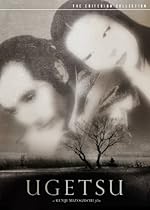 5. UGETSU (1953). Director Kenji Mizoguchi’s period piece, detailing the impact of civil war on two married couples, flirts with the horror genre in several scenes, ultimately turning into a ghost story. There are no overt shocks, but there are some wonderfully eerie moments when a husband realizes he is consorting with a ghost. The overall feeling is one of sorrow more than scares. The movie is ultimately about the price that women pay while their men try to achieve glory and honor during wartime. The result is a real tear-jerker that will have your girlfriend reaching for the tissue box and marveling at what a sensitive soul you are, while you enjoy the ghostly apparitions.
5. UGETSU (1953). Director Kenji Mizoguchi’s period piece, detailing the impact of civil war on two married couples, flirts with the horror genre in several scenes, ultimately turning into a ghost story. There are no overt shocks, but there are some wonderfully eerie moments when a husband realizes he is consorting with a ghost. The overall feeling is one of sorrow more than scares. The movie is ultimately about the price that women pay while their men try to achieve glory and honor during wartime. The result is a real tear-jerker that will have your girlfriend reaching for the tissue box and marveling at what a sensitive soul you are, while you enjoy the ghostly apparitions.
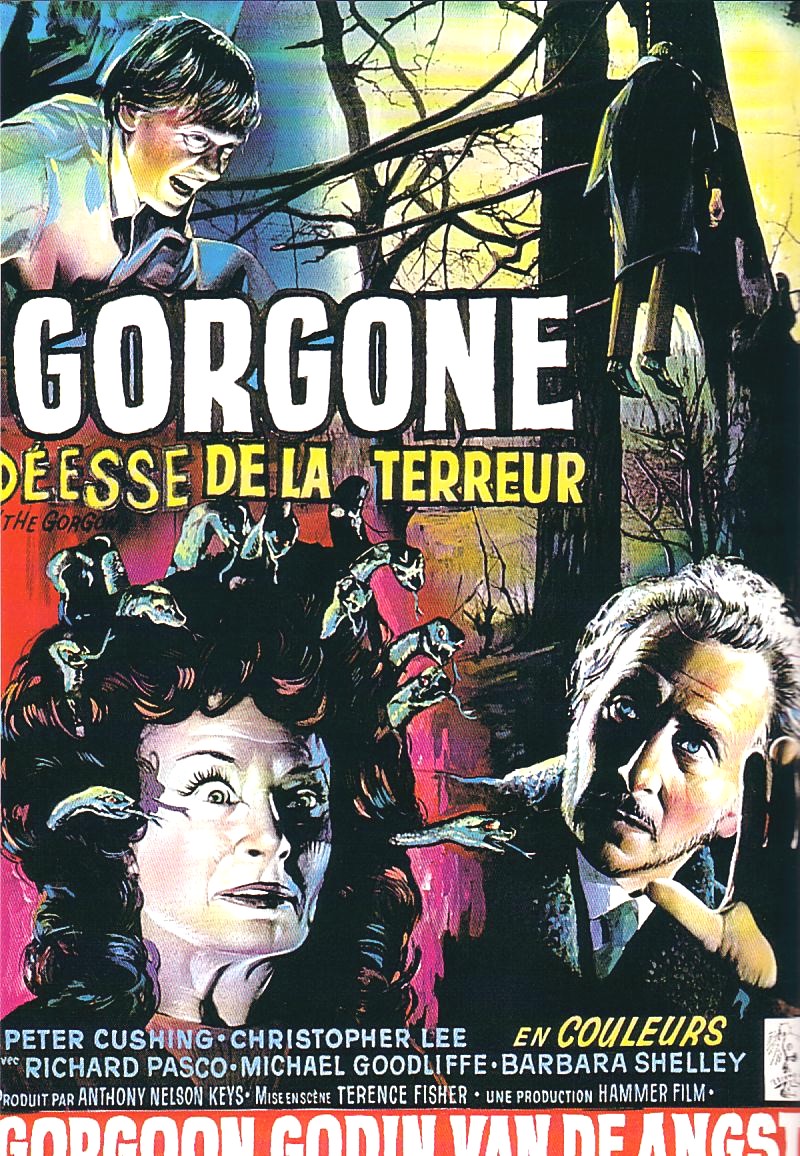 6. THE GORGON (1964). This is not the most effective Hammer horror film in terms of providing scares, but that is only because the emphasis is on romance. The film is a doomed love story about a young student named (Richard Pasco) who comes to a village where a monster is petrifying its victims. After a close encounter with the Gorgon, Paul is nursed back to health by Carla (Barbara Shelley) and falls in love with her. Carla, although she returns his affection, is bound by some dark power over her; eventually, we realize that during the full moon, she becomes the Gorgon. The dynamic acting duo of Peter Cushing and Christopher Lee are on hand as a doctor and a professor, each separately trying to solve the problem, but ultimately there is no hope for Carla or Paul. The film’s greatest achievement is that its horror effects are orchestrated for their emotional impact: this isn’t a movie that has you screaming in terror but weeping in sadness over the plight of the young lovers. The finale will have you and your lady-friend exchanging bodily fluids, but they will be tears of sadness.
6. THE GORGON (1964). This is not the most effective Hammer horror film in terms of providing scares, but that is only because the emphasis is on romance. The film is a doomed love story about a young student named (Richard Pasco) who comes to a village where a monster is petrifying its victims. After a close encounter with the Gorgon, Paul is nursed back to health by Carla (Barbara Shelley) and falls in love with her. Carla, although she returns his affection, is bound by some dark power over her; eventually, we realize that during the full moon, she becomes the Gorgon. The dynamic acting duo of Peter Cushing and Christopher Lee are on hand as a doctor and a professor, each separately trying to solve the problem, but ultimately there is no hope for Carla or Paul. The film’s greatest achievement is that its horror effects are orchestrated for their emotional impact: this isn’t a movie that has you screaming in terror but weeping in sadness over the plight of the young lovers. The finale will have you and your lady-friend exchanging bodily fluids, but they will be tears of sadness.
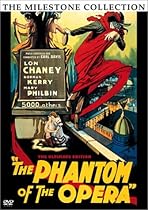 7. THE PHANTOM OF THE OPERA (1925). This famous tale of the deformed mystery man lurking beneath the Paris Opera House is now considered a horror film, but in its day it was more of a mystery-thriller-romance. Erik the Phantom (Lon Chaney) delivers a series of frights (including the famous unmasking of his horrifying visage), but the story is really about his hopeless love for the young and beautiful opera singer Christine (Mary Philbin). The style of this old silent film is dated and stagy, but Chaney keeps it interesting; also, the sets and photography capture the right atmosphere – part horror and part fairy tale – creating the perfect setting for the this variation on “Beauty and the Beast,” with the monster evoking sympathy because of the tender emotions hiding behind his ugly countenance. There have been several remakes. The 1962 version is perhaps even more of a chick flick in that it de-emphasizes the horror element and purifies the Phantom (Herbert Lom)’s motives: he’s no longer interested in Christine sexually, only spiritually. The result yields few frights, but the film possesses a tender quality rare in the horror genre – which should increase its appeal to the distaff side of the audience.
7. THE PHANTOM OF THE OPERA (1925). This famous tale of the deformed mystery man lurking beneath the Paris Opera House is now considered a horror film, but in its day it was more of a mystery-thriller-romance. Erik the Phantom (Lon Chaney) delivers a series of frights (including the famous unmasking of his horrifying visage), but the story is really about his hopeless love for the young and beautiful opera singer Christine (Mary Philbin). The style of this old silent film is dated and stagy, but Chaney keeps it interesting; also, the sets and photography capture the right atmosphere – part horror and part fairy tale – creating the perfect setting for the this variation on “Beauty and the Beast,” with the monster evoking sympathy because of the tender emotions hiding behind his ugly countenance. There have been several remakes. The 1962 version is perhaps even more of a chick flick in that it de-emphasizes the horror element and purifies the Phantom (Herbert Lom)’s motives: he’s no longer interested in Christine sexually, only spiritually. The result yields few frights, but the film possesses a tender quality rare in the horror genre – which should increase its appeal to the distaff side of the audience.
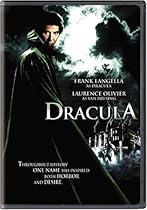 8. DRACULA (1979). There has always been a certain sexual innuendo underlying the Dracula myth, with the mysterious, dark, foreign stranger sneaking into the bedrooms of virginal British ladies. Bela Lugosi played up the foreign mystique, and Christopher Lee emphasized the sexual aggression, but Frank Langella turned the Count into a romantic anti-hero, dashing and seductive, who not only lusts for women (their bodies and their blood) but loves Lucy(Kate Nelligan) for her spirit and intelligence. In 1992, BRAM STOKER’S DRACULA, tries to emphasize the romance even more, but director Francis Ford Coppola fumbles, turning the story into an overwrought teen romance better suited to an episode of JERRY SPRINGER (vampires – and the women who love them).
8. DRACULA (1979). There has always been a certain sexual innuendo underlying the Dracula myth, with the mysterious, dark, foreign stranger sneaking into the bedrooms of virginal British ladies. Bela Lugosi played up the foreign mystique, and Christopher Lee emphasized the sexual aggression, but Frank Langella turned the Count into a romantic anti-hero, dashing and seductive, who not only lusts for women (their bodies and their blood) but loves Lucy(Kate Nelligan) for her spirit and intelligence. In 1992, BRAM STOKER’S DRACULA, tries to emphasize the romance even more, but director Francis Ford Coppola fumbles, turning the story into an overwrought teen romance better suited to an episode of JERRY SPRINGER (vampires – and the women who love them).
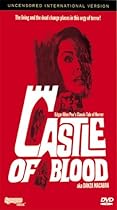 9. CASTLE OF BLOOD (1964). Allegedly based on the work of Edgar Alan Poe, this Italian Gothic horror story tells of Alan, a reporter who wagers he can spend a night alone in a haunted castle. He meets a variety of spooks, including a very alluring one named Elizabeth (played by Barbara Steele, the Queen of Horror). They fall in love, but being – literally – from two different worlds, they cannot stay together, or so it seems. As daylight draws near, the other ghosts come seeking the young man’s blood; Elizabeth tries to lead him to safety, but he dies on the verge of escape. The seemingly downbeat ending is actually a triumph of love over death. As the camera pans up to the sunlight, we hear the disembodied spirits of Alan and Elizabeth conversing, and we know that they are now together for eternity – the ultimate romantic fantasy. Steele also starred in a dual role as an innocent princess and a vampire-witch in the 1960 classic BLACK SUNDAY – a much more effective horror film that also has a strong romantic element, thanks to the chemistry between the princess and a young doctor (John Richardson) who seeks to save her from the vampire.
9. CASTLE OF BLOOD (1964). Allegedly based on the work of Edgar Alan Poe, this Italian Gothic horror story tells of Alan, a reporter who wagers he can spend a night alone in a haunted castle. He meets a variety of spooks, including a very alluring one named Elizabeth (played by Barbara Steele, the Queen of Horror). They fall in love, but being – literally – from two different worlds, they cannot stay together, or so it seems. As daylight draws near, the other ghosts come seeking the young man’s blood; Elizabeth tries to lead him to safety, but he dies on the verge of escape. The seemingly downbeat ending is actually a triumph of love over death. As the camera pans up to the sunlight, we hear the disembodied spirits of Alan and Elizabeth conversing, and we know that they are now together for eternity – the ultimate romantic fantasy. Steele also starred in a dual role as an innocent princess and a vampire-witch in the 1960 classic BLACK SUNDAY – a much more effective horror film that also has a strong romantic element, thanks to the chemistry between the princess and a young doctor (John Richardson) who seeks to save her from the vampire.
10. THE GIRL IN A SWING (1989). This small independent film, based on the novel by Richard Adams, is essentially a love story about a repressed British man (Rupert Frazer), who meets and marries a mysterious German girl named (Meg Tilly). In the great tradition of tragic romances, the marraige is doomed, but only gradually do hints of a haunting arise, related to some guilty secret of Karin’s. The relentless ghost is seldom seen, keeping the horror content to a minimum; instead, the film focuses on the tragedy of the relationship. Though far from a masterpiece, the film works in its own way, achieving its emotional effects with far less cheesy manipulation than LOVE STORY – and it has a ghost, too, so what more do you want?
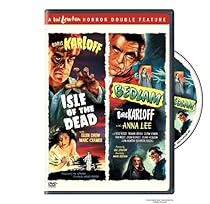 11. BEDLAM (1946). Another Val Lewton production, this period piece tells of an arrogant woman (Anna Lee) who is unfairly confined to the infamous English asylum. Although the official star is Boris Karloff (FRANKENSTEIN) as the asylum’s evil overlord, Lee gives a great performance in what is truly the lead role: charting her character’s arc from selfishness to concern for the other patients, she emerges as one of the great female characters in the history of horror cinema.
11. BEDLAM (1946). Another Val Lewton production, this period piece tells of an arrogant woman (Anna Lee) who is unfairly confined to the infamous English asylum. Although the official star is Boris Karloff (FRANKENSTEIN) as the asylum’s evil overlord, Lee gives a great performance in what is truly the lead role: charting her character’s arc from selfishness to concern for the other patients, she emerges as one of the great female characters in the history of horror cinema.
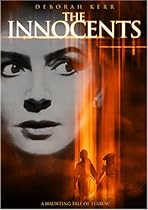 12. THE INNOCENTS (1960). This excellent English ghost story, based on Henry James’ The Turn of the Screw, stars Deborah Kerr as Miss Giddens, a governess put in charge of two children living in a secluded mansion. She gradually comes to believe that the house is haunted and that the children are in league with the ghosts. The film is deliberately ambiguous: are the ghosts real or is Miss Giddens imagining them? Either way, it is a wonderful portrait of a woman desperately dealing with a horrible situation without a hero to ride in and rescue her.
12. THE INNOCENTS (1960). This excellent English ghost story, based on Henry James’ The Turn of the Screw, stars Deborah Kerr as Miss Giddens, a governess put in charge of two children living in a secluded mansion. She gradually comes to believe that the house is haunted and that the children are in league with the ghosts. The film is deliberately ambiguous: are the ghosts real or is Miss Giddens imagining them? Either way, it is a wonderful portrait of a woman desperately dealing with a horrible situation without a hero to ride in and rescue her.
 13. THE HAUNTING (1963). Another great ghost story, this one portrays an attempt to investigate the “Mount Everest of Haunted Houses.” Based on Shirley Jackson’s The Haunting of Hill House, the story is told from the point of view of Nell (Julie Harris), a fragile young woman whose desperate need for love and acceptance lures her to succumb to Hill House. An effective scare-fest, this film is also a great character study that should appeal to female viewers. Men can enjoy the scares and the presence of Claire Bloom as Theo, whom the film none too subtly insinuates is a lesbian. The 1974 film THE LEGEND OF HELL HOUSE deals with a similar situation: a team of two men and two women attempt a sceintific investigation of a haunted house. The scares are a bit more overt, and the psychology less in depth, but the film retains some “chick flick” interest thanks to the performances of Pamela Franklyn and Gayle Hunnicutt, who help create characters that the women in the audience can identify with.
13. THE HAUNTING (1963). Another great ghost story, this one portrays an attempt to investigate the “Mount Everest of Haunted Houses.” Based on Shirley Jackson’s The Haunting of Hill House, the story is told from the point of view of Nell (Julie Harris), a fragile young woman whose desperate need for love and acceptance lures her to succumb to Hill House. An effective scare-fest, this film is also a great character study that should appeal to female viewers. Men can enjoy the scares and the presence of Claire Bloom as Theo, whom the film none too subtly insinuates is a lesbian. The 1974 film THE LEGEND OF HELL HOUSE deals with a similar situation: a team of two men and two women attempt a sceintific investigation of a haunted house. The scares are a bit more overt, and the psychology less in depth, but the film retains some “chick flick” interest thanks to the performances of Pamela Franklyn and Gayle Hunnicutt, who help create characters that the women in the audience can identify with.
 14. THE OTHERS (2001). Intentionally molded in the tradition of THE INNOCENTS, this ghost story features another strong female lead, in this case played by the talented Nicole Kidman. The scares are extremely effective, but what holds interest from beginning to end is the focus on Kidman’s Grace Stewart as she desperately tries to protect her children from the mysterious forces at work in their isolated house.
14. THE OTHERS (2001). Intentionally molded in the tradition of THE INNOCENTS, this ghost story features another strong female lead, in this case played by the talented Nicole Kidman. The scares are extremely effective, but what holds interest from beginning to end is the focus on Kidman’s Grace Stewart as she desperately tries to protect her children from the mysterious forces at work in their isolated house.
 15. THE ORPHANAGE (2007). Belen Rueda stars as Laura, a woman whose son goes missing in their new house, possibly abducted by ghosts. As with the three previous entries on our list, this film orchestrates a series of unnerving spooky encounters while focusing on the drama of the woman trying to deal with them. There is also a strong maternal element that plays well with women. Although vulnerable, Laura is not a Scream Queen or a victim; she’s not even the traditional “Final Girl” who survives and triumphs. She’s a complex, damaged woman who keeps going even when pushed to extremes. The film was executive produced by Guillermo Del Toro, whose PAN’S LABYRINTH and THE DEVIL’S BACKBONE may also appeal to women, because of their portrait of childhood innocence menaced by adult horrors, with empahsis on emotional content.
15. THE ORPHANAGE (2007). Belen Rueda stars as Laura, a woman whose son goes missing in their new house, possibly abducted by ghosts. As with the three previous entries on our list, this film orchestrates a series of unnerving spooky encounters while focusing on the drama of the woman trying to deal with them. There is also a strong maternal element that plays well with women. Although vulnerable, Laura is not a Scream Queen or a victim; she’s not even the traditional “Final Girl” who survives and triumphs. She’s a complex, damaged woman who keeps going even when pushed to extremes. The film was executive produced by Guillermo Del Toro, whose PAN’S LABYRINTH and THE DEVIL’S BACKBONE may also appeal to women, because of their portrait of childhood innocence menaced by adult horrors, with empahsis on emotional content.
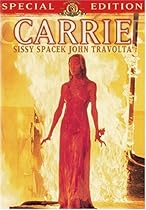 16. CARRIE (1976). Despite director Brian DePalma’s reputation as a cinematic misogynist, this hit horror film features two actresses (Sissy Spacek and Piper Laurie) in strong roles, giving Oscar-nominated performances. This is more a high-school horror film than a chick flick, but it captures a sense of ordinary people living in a world we all recognize, and despite the horrible vengeance she ultimately unleashes on her tormentors, Carrie remains a sympathetic character that women – and men – can relate to.
16. CARRIE (1976). Despite director Brian DePalma’s reputation as a cinematic misogynist, this hit horror film features two actresses (Sissy Spacek and Piper Laurie) in strong roles, giving Oscar-nominated performances. This is more a high-school horror film than a chick flick, but it captures a sense of ordinary people living in a world we all recognize, and despite the horrible vengeance she ultimately unleashes on her tormentors, Carrie remains a sympathetic character that women – and men – can relate to.
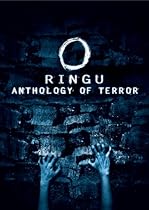 17 RING 0: BIRTHDAY (2000). This prequel to 1998’s RING (the film that launches the recent J-Horror wave) covers some of the same territory as CARRIE. Set in a small acting troup, it tells the story of Sadako (Yukie Nakama), a young misfit with strange powers, who is tormented by her fellow thespians until she turns the tables. Presenting a far more sympathetic portrait of Sadako than seen in the other RING films, this is pretty much a bust as a horror film, but it is an interesting portrait of a sad, lonely, mixed up girl trying to fit in. In general, ghost movies from Japan and other Asian nations should find favor with female viewers: they tend to feature female characters as the protagonists, and the restless spirits are almost always women, their power in death redressing the imbalance they suffered during their lives under a patriarchal culture. Besides RING, check out PHONE, THE EYE, JU-ON: THE GRUDGE, and SHUTTER.
17 RING 0: BIRTHDAY (2000). This prequel to 1998’s RING (the film that launches the recent J-Horror wave) covers some of the same territory as CARRIE. Set in a small acting troup, it tells the story of Sadako (Yukie Nakama), a young misfit with strange powers, who is tormented by her fellow thespians until she turns the tables. Presenting a far more sympathetic portrait of Sadako than seen in the other RING films, this is pretty much a bust as a horror film, but it is an interesting portrait of a sad, lonely, mixed up girl trying to fit in. In general, ghost movies from Japan and other Asian nations should find favor with female viewers: they tend to feature female characters as the protagonists, and the restless spirits are almost always women, their power in death redressing the imbalance they suffered during their lives under a patriarchal culture. Besides RING, check out PHONE, THE EYE, JU-ON: THE GRUDGE, and SHUTTER.
 18. ONIBABA (1964). This black-and-white Japanese horror classic has few traditional chick flick elements, but it focuses on two women in the lead roles. Like UGETSU, it portrays the suffering of women while their men are away at war; in this case a young woman and her mother-in-law make ends meet me murdering lone samurai and selling their armour. Toward the end there is a demonic appartion and possibly a curse, but much of the film’s appeal lies in watching the women dish out death to the men who fall into their trap.
18. ONIBABA (1964). This black-and-white Japanese horror classic has few traditional chick flick elements, but it focuses on two women in the lead roles. Like UGETSU, it portrays the suffering of women while their men are away at war; in this case a young woman and her mother-in-law make ends meet me murdering lone samurai and selling their armour. Toward the end there is a demonic appartion and possibly a curse, but much of the film’s appeal lies in watching the women dish out death to the men who fall into their trap.
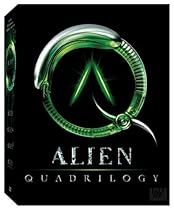 19. ALIEN (1979). There is not much about this film that labels it as a chick flick, but it does feature Sigourney Weaver as Warrant Officer Ripley, the character who once and for all over-turned the cliche of women as helpless screaming victims in monster movies. That should be enough to get your girlfriend to sit through the chest-burster and other horrors on display.
19. ALIEN (1979). There is not much about this film that labels it as a chick flick, but it does feature Sigourney Weaver as Warrant Officer Ripley, the character who once and for all over-turned the cliche of women as helpless screaming victims in monster movies. That should be enough to get your girlfriend to sit through the chest-burster and other horrors on display.
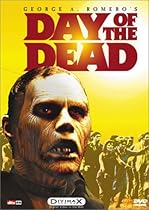 20. DAY OF THE DEAD(1985). This last title is really pushing it, but we think you deserve something in return for making the effort to find common ground with your squeamish main squeeze. After sitting through all those Gothic Romances, subtle ghost stories, and psychological terror tales, you want some gruesome gore, right? Well, this film from writer-director George Romero is just the thing: it’s brimming with blood, but it also has a strong female character in the lead, Lori Cardilel as Sarah. Inverting the formula of NIGHT OF THE LIVING DEAD, in which Barbra (Judith O’Dea) was pretty much a useless space case, Romero makes Sarah the only one who can keep her shit together while humanity totters on the brink of extinction. That may not make it a chick flick, but it should offer at least a little redeeming value for making the love your life watch a man ripped in half by cannibalistic zombies.
20. DAY OF THE DEAD(1985). This last title is really pushing it, but we think you deserve something in return for making the effort to find common ground with your squeamish main squeeze. After sitting through all those Gothic Romances, subtle ghost stories, and psychological terror tales, you want some gruesome gore, right? Well, this film from writer-director George Romero is just the thing: it’s brimming with blood, but it also has a strong female character in the lead, Lori Cardilel as Sarah. Inverting the formula of NIGHT OF THE LIVING DEAD, in which Barbra (Judith O’Dea) was pretty much a useless space case, Romero makes Sarah the only one who can keep her shit together while humanity totters on the brink of extinction. That may not make it a chick flick, but it should offer at least a little redeeming value for making the love your life watch a man ripped in half by cannibalistic zombies.
If you are interested in the films on this list, most of them are reviewed more fully elsewhere on the website. You can access the reviews by clicking on the titles that contain hyperlinks.
NOTE: Yes, this article makes sexist assumptions about what constitutes a “chick flick,” and we know that some women do not like the term – an issue we addressed in this previous editorial.
UPDATE (04/27/08): We have received some suggestions for titles we overlooked:
- Lucius Gore of Eplatter recommends SCREAM. I suppose the combination of humor and a strong “Final Girl” character would appeal to women more than a standard slasher movie.
- Brian Collins of Horror Movie a Day recommends GINGER SNAPS.
- Jeff Allard of Dinner with Max Jenke believes that ALIENS has a greater female appeal than ALIEN, which makes sense, considering the maternal themes in the film. He also recommends ROSEMARY’S BABY – which is such an obvious choice that I am embarrassed to have overlooked it. Roman Polanski’s adaptation of the Ira Levin novel is considered to be one of the greatest horror movies ever made (EXORCIST director William Friedkin puts it on his very short list here), and it’s all about a young married woman (Mia Farrow)undergoing her first pregnancy. Yes, we all know she is going to give birth to the spawn of Satan – or is she? The film actually delivers little-to-no evidence on this score except the professed belief of the Satanic cult (we’re supposed to trust them?). In a way, the movie plays out as a drama about a woman undergoing a trouble pregnancy, who is betrayed by her husband, and bedeviled by some kooky neighbors. In othe words, it is very much set in the real world, and features a situation that is completely relatable; even if the details are extreme, almost any woman could watch this movie and identify with what poor Rosemary is suffering.
UPDATE (01/28/09): Someone on an IMDB message board thread, linking to this article, suggested that THE DESCENT should have made the list.
Curse of Frankenstein (1957) – Horror Film Review
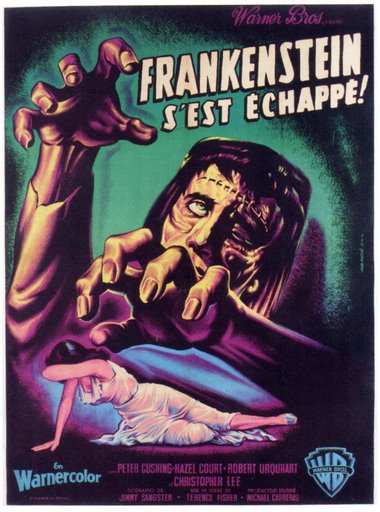 This is the mad scientist’s experiment that resurrected the Gothic tradition in cinema and created the second great wave of monsters movies. (In the 1930s and ’40s, Universal had given us black-and-white horrors like DRACULA and FRANKENSTEIN.) The first of many reinventions of classic movie monsters by Britain`s Hammer Films, CURSE OF FRANKENSTEIN established new style for horror – bold, bloody, beautiful – that completely broke tradition with the cobwebby classics of the 1930s and 1940s. The film also gave us two new horror stars, Peter Cushing and Christopher Lee, who – along with director Terence Fisher – would go on to redefine the genre for the next decade and a half. Some of their subsequent collaborations (notably 1958’s HORROR OF DRACULA) equaled or surpassed their achievement here, but this remains their original classic, the grimoire establishing the magic formula they would use again and again.
This is the mad scientist’s experiment that resurrected the Gothic tradition in cinema and created the second great wave of monsters movies. (In the 1930s and ’40s, Universal had given us black-and-white horrors like DRACULA and FRANKENSTEIN.) The first of many reinventions of classic movie monsters by Britain`s Hammer Films, CURSE OF FRANKENSTEIN established new style for horror – bold, bloody, beautiful – that completely broke tradition with the cobwebby classics of the 1930s and 1940s. The film also gave us two new horror stars, Peter Cushing and Christopher Lee, who – along with director Terence Fisher – would go on to redefine the genre for the next decade and a half. Some of their subsequent collaborations (notably 1958’s HORROR OF DRACULA) equaled or surpassed their achievement here, but this remains their original classic, the grimoire establishing the magic formula they would use again and again.
In the mid-1950s, aspiring producers Milton Subotsky and Max J. Rosenberg approached one of Hammer’s executives with a script Subotsky had adapted from Mary Shelley’s novel Frankenstein, the archetypal tale of a man-made monster. Hammer purchased the script (which, according to Subotsky, remained faithful to the source material), discarded it, and had Jimmy Sangster write something totally new.
Apparently, the original idea had been to create a fairly traditional horror film, possibly casting the aging Boris Karloff as Baron Frankenstein. Fortunately, Hammer realized that, although Shelley’s novel was in public domain, the 1931 film version of FRANEKNSTEIN, starring Karloff as the monster, was still under copyright to Universal Studios; therefore, any similarity to that horror classic, particularly the famous flat-head makeup devised by Jack Pierce, could result in a lawsuit.
Consequently, Sangster’s screenplay discarded most of the familiar elements. About all the remained from the novel was the concept of creation, some character names, and a few bits and pieces, stitched together into something almost entirely new. Only two points were carried over from the Universal films: Frankenstein is still a Baron (he had no title in the novel), and his creation is mute (unlike Shelly’s articulate creature).
Frankenstein (embodied perfectly by Peter Cushing) is no longer the nervous inventor who creates a man in a fit of enthusiasm and immediately regrets his rash action. Cushing’s Baron is precise and cold as a scalpel, a handsome blue-eyed dandy who has a way with women (at least with the maid) and never blinks or hesitates in pursuit of his goal. In truth, he is the real source of the horror in the story; his completely amoral detachment from the consequences of his work is more disturbing than the actual gore (which, though shocking for its time, is actually mild). And this moral horror is accentuated by the fact that Cushing’s performance (his dapper air and smiling confidence) actively invites the audience to identify with him even as the film tells in no uncertain terms that what he is doing is evil.
In this context, Christopher Lee’s creature has no chance of attaining Karloff’s stature. He’s a bit more of a simple monster, with less emphasis on his suffering and misunderstanding. His real function is as a sort of silent rebuke to his creator: all of Frankenstein’s grand dreams of perfection have resulted in a pathetic patchwork that barely seems stitched together. As in most Frankenstein stories and films, the creation is, ultimately, a kind of dark doppelganger to his creator, even acting out Frankenstein’s murderous intentions. (The Baron locks the maid in a cell with the creature when she gets to nosey. The scene is all the more effective for its suggestiveness, dissolving away as the woman screams when the creature reaches out for her, leaving it unclear whether his intention is murder or rape. The juxtaposition with subsequent scene, with the Baron enjoy a convivial breakfast, is so incongruous that the result is an excellent piece of black humor: when the Baron asks his fiancé to “pass the marmalade,” as if nothing untoward had recently happened, the viewer is forced to laugh in wicked admiration of Frankenstein’s cheek.)
The film is also notable for the way it re-imagines one of the genre’s most overused clichés: the mad scientist’s assistant. In the 1930s films, such characters were named Fritz or Igor; they usually had hunched back, and their purpose was usually to wander around looking creepy—an added bit of visual unpleasantness during an era when physical deformity was much on the public mind (thanks to soldiers returning home after being maimed on the battlefields of World War One). In CURSE OF FRANKENSTEIN, the “assistant” is actually Frankenstein’s former teacher (the pupil becomes the master). Played by Robert Urquhart, Paul Krempe is the voice of decency, moderation, and restraint—the conscience that Frankenstein refuses to heed. He is also a sort of emotional barometer for the audience, his reactions to Frankenstein’s work expressing the moral outrage we are meant to feel.
If the film has any weaknesses, they lay in the somewhat slow pacing of the early scenes, which also feature a less than assured performance by Melvyn Hayes as the young Victor Frankenstein. Perhaps his fresh-faced innocence is supposed to supply a contrast with the steely-eyed determination of his adult self, but the effect backfires, providing too little foreshadowing of what is too come and leaving the early scenes feeling empty, without the galvanizing impact of Cushing’s presence. Fortunately, once Cushing arrives on screen, the film sparks with energy, and you have to watch in awe as he ruthlessly establishes a new standard for mad science on screen, one that is all the more horrible for looking so attractive, so assured, and so unperturbably cool.
The film was shot in Technicolor by Jack Asher, under the direction of Terence Fisher, working on a budget of 65,000 pounds (approximately $150,000). The script eliminated all of the novel’s globe-trotting, so Bernard Robinson’s production design could concentrate—quite brilliantly—on the Baron’s luxurious castle, creating an almost decadent sense of a polite aristocratic facade presiding over the “workshop of filthy creation” in the basement. James Bernard supplied the first of many effective musical accompaniments.
The result is a timeless classic that stands up as well as the best of Universal’s 1930s horror films. The film’s novel approach changed the face of horror, replacing black-and-white shadows with colorful grue. The huge (and unexpected) success launched Hammer into the horror genre for most of the next two decades, creating numerous new versions of classic movies monsters (THE MUMMY, THE TWO FACES OF DR. JEKYLL, THE CURSE OF THE WEREWOLF, etc), not to mention numerous Frankenstein sequels (REVENGE OF FRANKENSTEIN, FRANKENSTEIN CREATED WOMAN, FRANKENSTEIN MUST BE DESTROYED, etc), some of which were as good as (and possibly even better than) the original.
If anything, time has been kind to CURSE OF FRANKENSTEIN, which was chastised in its time for being tastelessly explicit and for failing to establish an effective atmosphere. (Critic R. D. Smith proclaimed, “For all lovers of the cinema, only two words describe this film – Depressing, Degrading!”) Decades later, the shock of Technicolor gore has long worn off – which is ultimately a good thing, because it proves that Smith and other contemporary critics, who derided the film for its graphic violence, were completely wrong. The true horror of in Sangster’s screenplay is moral in nature, and it continues to make the skin crawl today, thanks to the incisive performance of Cushing as the Baron – never flinching from his purpose, despite the accumulating atrocities he must commit. The appalling lack of conscience is underlined director Fisher’s careful use of reaction shots emphasizing the disgusted reactions of the mad scientist’s former mentor.
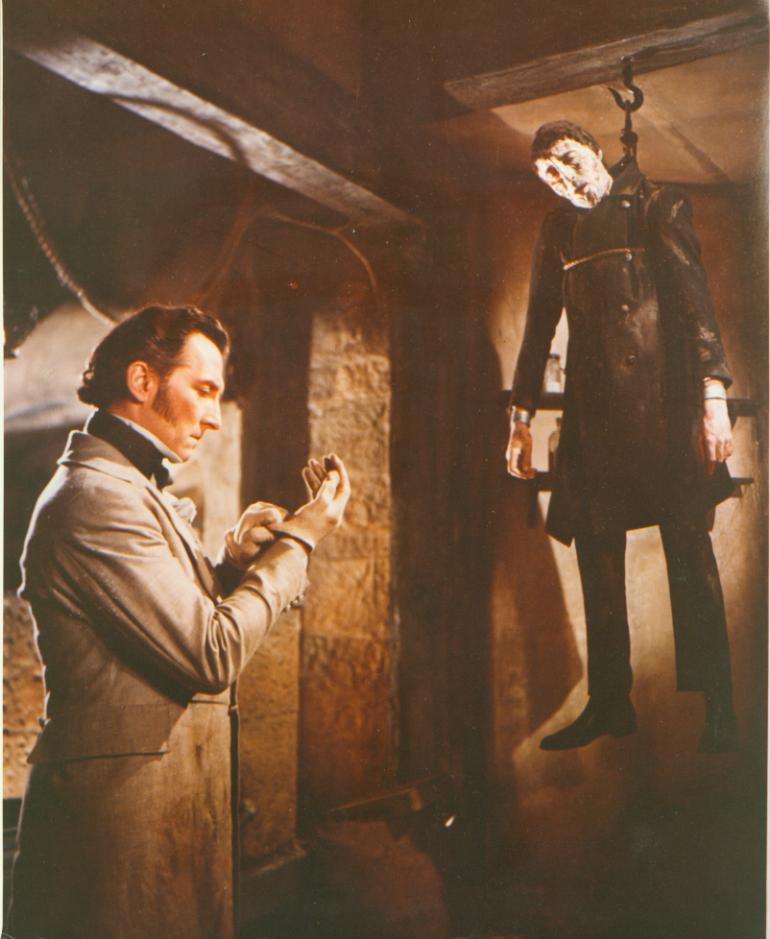 Subsequent viewings also benefit Lee’s performance as the creature. Often viewed as little more than a killing machine, lacking the soul of Karloff’s monster, Lee’s interpretation reveals a surprising sense of sympathy for the shambling being. And the color makeup by Phil Leaky may not match the iconic stature of Pierce’s work on Karloff, but it does suggest a more believable result of surgery—a creature that really does seem to have been stitched together piecemeal by Frankenstein.
Subsequent viewings also benefit Lee’s performance as the creature. Often viewed as little more than a killing machine, lacking the soul of Karloff’s monster, Lee’s interpretation reveals a surprising sense of sympathy for the shambling being. And the color makeup by Phil Leaky may not match the iconic stature of Pierce’s work on Karloff, but it does suggest a more believable result of surgery—a creature that really does seem to have been stitched together piecemeal by Frankenstein.
Ultimately, the enduring appeal of CURSE OF FRANKENSTEIN rests in Cushing interpretation of the Baron. The late actor, who professed to having “a tremendous amount of affection for Baron Frankenstein,” said that, besides Mary Shelley’s novel, he based his interpretation of Frankenstein upon Dr. Robert Knox, the anatomy teacher who suffered a scandal when it was learned that the cadavers he used to teach his students had been illegally obtained –and in some cases murdered – by Burke and Hare. Many believed that Knox must have known what was happening, and simply turned a blind eye in the name of science. “I try to base Frankenstein on a man who is, fundamentally, trying to do something for the good of mankind, as indeed Knox was, but against all odds….”
Indeed, the odds always thwart Frankenstein, not only in this film but also in the sequels, eternally depriving him of the success he so ardently desires. There is some dark fascination in this eternally fruitless quest, enough to keep the Frankenstein franchise fresh until its conclusion in 1972’s FRANKENSTEIN AND THE MONSTER FROM HELL. But CURSE OF FRANKENSTEIN remains the classic film that started it all, like a burst of electricity that still gleams to this day, forever illuminating the mad scientist’s lab equipment—and the awful results—in our minds.
TRIVIA
Milton Subotsky and Max J. Rosenberg, the duo who had sold their unfilmed Frankenstein script to Hammer, later formed Amicus Films. The company became Hammer’s chief English competitor in the horror genre during the 1960s. Subotsky and Rosenberg produced numerous terror titles like HORROR HOTEL, DR. TERROR’S HOUSE OF HORRORS, and TORTURE GARDEN, usually starring Christopher Lee and/or Peter Cushing.
CURSE OF FRANKENSTEIN (1957). Directed by Terence Fisher. Screenplay by Jimmy Sangster, based on the novel by Mary Shelley. Cast: Peter Cushing, Christopher Lee, Robert Uquhart, Hazel Court, Valerie Gaunt.
RELATED ARTICLES:
- Obituary: Hazel Court
Tenebre (1982) – Horror Film DVD Review
 Italian maestro of horror Dario Argento reaches his peak with this modern thriller about a mystery author whose latest book is serving as inspiration for a series of brutal murders that take place while he is on a promotional tour in Rome. The film synthesizes all the familiar Argento motifs (psycho killers, bloody violence, convoluted plot twists, pulse pounding music) into an almost perfect symphony of fear that overcomes many of his traditional shortcomings (credibility and characterization). The truly impressive achievement of this movie is that it is not just a collection of outrageous set pieces, tied together by an off-the-wall plot; it is a compact, tightly structured unit that attacks the viewer’s comfort zone with all the precision of a deftly wielded scalpel.
Italian maestro of horror Dario Argento reaches his peak with this modern thriller about a mystery author whose latest book is serving as inspiration for a series of brutal murders that take place while he is on a promotional tour in Rome. The film synthesizes all the familiar Argento motifs (psycho killers, bloody violence, convoluted plot twists, pulse pounding music) into an almost perfect symphony of fear that overcomes many of his traditional shortcomings (credibility and characterization). The truly impressive achievement of this movie is that it is not just a collection of outrageous set pieces, tied together by an off-the-wall plot; it is a compact, tightly structured unit that attacks the viewer’s comfort zone with all the precision of a deftly wielded scalpel.
The film begins with a brief pre-credits prologue of a black-gloved figure reading from Peter Neal’s novel (titled, with intentional self-reference, “Tenebre”) – a disturbing passage describing a maniac’s joy at realizing he can sweep away the obstacles in his life through the simple act of murder. The story then follows Neal, who embarks on a plane trip to Italy. In the airport we see him stalked by a beautiful woman, and when he arrives, he finds his luggage has been vandalized. Meanwhile, a seductive kleptomaniac is stalked and killed in Rome, the pages of “Tenebre” stuffed into her mouth. During interviews about his book, Neal is surprised to find himself under attack from a former student, now a journalist, who accuses him of writing macho, misogynistic bullshit that exploits women as victims of violence; the journalist and her lesbian lover are later brutally murdered. Neal then finds himself on the end of a disturbing series of messages from the killer, who claims he wants to eliminate “deviants” from society. The police make little headway, prompting Neal – in the great tradition of amateur detectives – to match wits with them. His prime suspect is a fussy interviewer whose questions sounded suspiciously similar to the killer’s statements, but that theory seems to die a bloody death when the interviewer is dispatched by a hatchet to the head. Afraid he may be the next victim, Neal decides to leave Rome, but the murders continue; the victims include Neal’s ex-fiancé Jane (the beautiful woman who trashed his luggage at the airport) and his agent (John Saxon), who have been having an affair behind his back.
SPOILER Police Detective Germani (Giuliano Gemma) finally figures out the truth: the interviewer was the murderer, but Neal killed him and took his place, killing his agent and his former fiancé, so that the deaths would be blamed on the serial killer. Confronted by Germani, Neal slices his own throat, but moments later, his body is gone, and Germani realizes he has been fooled by a fake razor blade. The realization comes too late to save his life: Neal axes him to death from behind. Neal then waits for his next victim, Ann (Dario Nicolodi), who has been waiting outside for Germani, but when she opens the door, she knocks over an abstract heavy metal sculpture, a sharp cone piercing Neal’s chest and pinning him to the wall, where he struggles like a pinned bug, his bloody hands trying to pull himself free but slipping uselessly on the smooth metallic surface, until he expires. Shocked to stupefaction by the bloody horror surrounding her, Ann raises her head and screams as the film fades to black… END SPOILER
This synopsis probably does a poor job of conveying the film’s greatness. The relatively strong plot (at least by Argento’s standards) is at first deceptively traditional; then it bends, twists, and ultimately breaks, undermining audience expectations in a disarming way. With its mystery author trying to solve an actual murder, the story is deliberately working within the mold of a classic who-done-it, in which amateur detectives inevitably outwit their professional competition (think of Agatha Christie’s Miss Marple or the television series MURDER, SHE WROTE). The message of this kind of fiction is that the world makes sense in a rational way. No matter how strange the crime, no matter how mysterious the murder, it will all make sense when the detective brings his acumen to bear upon the evidence, piecing the puzzle together until it leads him inevitably to the truth.
The script for TENEBRAE deliberately invokes this comparison by quoting Sherlock Holmes’ most famous dictum: “When you have eliminated everything else as impossible, whatever remains, however improbable, must be the truth.” But having evoked the spirit of the great sleuth and all he stands for, the film then proceeds to demolish the logical worldview with a series of extravagant set pieces that deliberately undermine our rational understanding of what’s happening.
The first is a long, almost gratuitous sequence in which a girl who works at the hotel where Peter is staying is left stranded during a date, then chased by an angry Doberman, and forced to take refuge in a house – which turns out to belong to the killer. She is not his usual kind of target, but he must kill her anyway to preserve his secret. In other words, even his rigid, psychotic pattern of behavior is undermined by the chaos and coincidence of the world at large.
This idea is complimented by a series of flashbacks that purport to reveal some insight into the murderer’s motives: We see four young men, their faces concealed, pursuing a seductive woman on the beach. Three of them find favor in her eyes, but she turns thumbs down on the fourth – who, in a fit of sexual frustration, slaps her face. In revenge, the other three boys pin the fourth one to the ground while the young woman forces her red stiletto heel into his mouth and down his throat. This excellently constructed sequence (filmed entirely without dialogue) conveys a sense of submerged seething rage that explodes past all rational boundaries. It doesn’t literally “explain” the subsequent murders, but it does make us feel the madness lurking within the murderer. Inevitably, we realize that when someone is working on his level, the chaos of the world has become internalized, and trying to sort it out logically may be a hopeless exercise in futility.
This proves to be the case for the police. Rational motives like robbery don’t apply to either of the film’s two killers. Neal may seem to be acting out of revenge, but his revenge makes little sense (he’s already split with Jane so why should he care if she’s having an affair?) – unless one realizes that he is really acting out his anger toward the young seductress seen in flashbacks (a fact underlined when Jane receives a pair of red high-heeled shoes shortly before she is targeted for death – the same red shoes that the nameless seductress used to force her heel down Neal’s throat).
Always a master of the visual flourish, Argento serves up the murders with a gusto that will make your skin crawl. The imagery is justifiably renowned; at times, it’s almost insane in its brilliance, as when the police inspector bends down to pick up a piece of evidence and the killer is revealed standing directly behind him — where he could not possibly be, in any logical scheme of things. (The nightmarish effectiveness of this shot was copped by Brian DePalma, to less effect, for the end of RAISING CAIN.) Equally brilliant is the film’s famous Louma crane shot, which conveys the menacing presence of the unseen killer by prowling up one side of a building, across the roof, and down the other side, accompanied to nerve-wracking music by Claudio Simonetti, Fabio Pignatelli, and Massimo Morante. (As part of the rock group Goblin, they had scored Argento’s DEEP RED and SUSPIRIA. Here, they provide one of their most effective, pulse-pounding soundtracks – sinister, demented, and exciting.)
Even more excessive is the death of Jane, whose severed arm sprays a vibrant slash of red against the white wall of her kitchen – a sick visual joke the deliberately evokes the splattery artistic effect of paintings by Jackson Pollack. It’s Argento’s way of insisting that his violent films are artistically valid in their own shocking way. (In an audio commentary recorded for the old Anchor Bay laserdisc release, Argento comments, “She’s painting. But no one ever says, ‘Dario, is art.’ They say, ‘Dario, is too bloody — you must cut.’”)
Despite these eruptions of Grand Guignol bloodshed, Argento shows he is a master of more than just gore. His handling of the exposition scenes is deft, and he stages the brief bits of police action like a sharply handled episode of MIAMIC VICE. One of the film’s highlights is actually a clever homage to Alfred Hitchcock’s REAR WINDOW, a long static sequence in which Peter Neal’s agent (deftly played by John Saxon) sits on a bench in a public square, waiting to meet Jane.
The film has clued us in to expect a murderous attack, and Argento strings us along for as long as humanly possible, milking suspense out of practically no on-screen action at all. Saxon sits and stares, his gaze shifting to people around him as he eavesdrops on their lives from a distance (as Jimmy Stewart’s wheelchair-bound character did in the Hitchcock film). Every new angle, every reaction shot, leaves us peering into the corner of the frame, looking for something dreadful. By the end of the sequence, simple actions like turning to watch a child retrieving his ball, or bumping into a passerby, are fraught with menace – all based on our anticipation that the killer will strike at any second.
What makes this scene even more remarkable is that it is set in the least likely place for a horror sequence: a brightly lit, wide-open plaza, seemingly devoid of menace. But that’s all part of Argento’s plan to overturn conventions and startle us with the unexpected. This is probably the greatest horror film ever made with the lights on, so to speak; it’s a perfect companion piece and contrast to DEEP RED, abandoning the shadowy historical architecture and night-time settings of the earlier film, in exchange for a bright, modernistic approach filled with gleaming buildings of concrete and steel. Although both films are set in Rome, TENEBRAE has not a single shot of a historical monument: the horrors here do not hide in the shadows of decaying mansions; they stride boldly in the daylight.
More importantly, the film is genuinely unsettling (in a way that his much more popular SUSPIRIA never was). It’s true target is not the on-screen victims but the viewers themselves, who are told in no uncertain terms that their worst fears about the horror genre are all true: the people who create it and those who enjoy it are equally crazy partners in a homicidal ballet. In one of the film’s sick jokes, we’re made to resent a woman reporter who questions the misogynistic content of the genre–who is then killed off by a crazed fan, her violent death thus (inadvertently) proving the point she was trying to make.
Lastly, star Anthony Franciosa deserves special mention for his performance as mystery writer Peter Neal. It is no newsflash to state that viewers traditionally do not go to Dario Argento films expecting great characterization and performances; however, Franciosa delivers a strong performance that anchors the film, giving it a level of credibility sometimes lacking in Argento’s other work. The script does not give the character enough depth and shading to compete with genre icons like Norman Bates, but Franciosa (as Max Von Sydow would later do in SLEEPLESS) works with the material, making Neal believable and sympathetic, while also managing a few nice touches of comic relief (e.g., his startled reaction when his traumatized assistant runs a red light without even noticing). Thanks to Franciosa, what could have been just an arbitrary, mechanical twist at the end of the story, turns instead into a startling dramatic development.
TRIVIA
The dialogue misattributes Sherlock Holmes’ famous dictum (“When you have eliminated everything else as impossible, whatever remains, however improbable, must be the truth”) to the novel “The Hound of the Baskervilles.” The famous sleuth first made a variation of this remark in Sir Arthur Conan Doyle’s second Holmes novel “The Sign of the Four.” He expressed similar sentiments in subsequent short stories, but not in “Hound of the Baskervilles.”
After the international success of SUPSPIRIA, Dario Argento followed up with the excellent INFERNO, the second of his uncompleted “Three Mothers Trilogy” (about three ancient beings, each sequestered in a different old mansion around the world). However, the sequel never got the wide release it deserved from 20th Century Fox (which had made a ton of money on the first film, under a subsidiary label). Consequently, Argento abandoned plans trilogy of supernatural terror and returned to the giallo format with this, probably his greatest film. Perhaps not coincidentally, Aria Pieroni (who appeared briefly as the “Third Mother” in INFERNO) is killed off early in TENEBRAE, presumably signaling Argento’s intent to kill of the Three Mothers trilogy before it was completed.
TENEBRE is part of a long tradition of “giallo” thrillers in Italy. The word, which literally means “yellow,” refers to the color of the cheap pulp paper on which mystery thriller novels were printed. Usually inspired by Hitchcock’s PSYCHO, most Italian giallo thrillers deal with masked madmen stalking and killing beautiful women, often employing a visual style inspired by film noir, using lots of darkness and shadows. Some Italian film critics have objected to this noir style, on the grounds that Italy is a Mediterranean country noted for its sunshine. To a large extent, TENEBRAE is an ironic joke on this criticism; despite the title’s literal meaning (“darkness”), the film has few shadows, takes place largely in daylight, and features brightly lit modern architecture even when the setting is night.
The word “Tenebrae” also refers to a ceremony in the Catholic Church, wherein the lights are extinguished.
Although an Italian film, TENEBRE was shot in English to increase its export value, then dubbed into Italian for domestic constumption.
For English-language prints, the voice of Ann (Daria Nicolodi) was dubbed by actress Therese Russell.
Eva Robbins, who plays the seductive woman on the dunes seen in flashbacks, is actually a man.
In the U.S., the screenplay is credited as a collaboration between Dario Argento and George Kemp, but some sources credit the screenplay solely to Argento, suggesting that Kemp is a pseudonym created by the American distributor to make the film sound less Italian.
When the film was originally released in the U.S. (direct to video), the title was changed to UNSANE, and several minutes were cut out, including much of the violence and the famous Louma crane shot.
DVD DETAILS
 Anchor Bay’s 1999 DVD of TENEBRAE recreates the features of their previous laserdisc release: a trailer, an audio commentary, and a version of the closing credits with alternate music (a bad pop song, instead of the main title theme by Morante-Simonetti-Pignatelli). The DVD also added two behind-the-scenes segements. Although billed as “uncut,” the film is actually missing a few insignificant shots; due to print damage, an absolutely complete version was not available. In 2001, this DVD was combined with Argento’s previous giallo effort DEEP RED on a double-bill DVD; both 1999 and 2001 DVDs are out of print, but TENEBRE was reissued by Starz/Anchor Bay in 2008 as a single disc, in conjunction with the Dario Argento Box Set.
Anchor Bay’s 1999 DVD of TENEBRAE recreates the features of their previous laserdisc release: a trailer, an audio commentary, and a version of the closing credits with alternate music (a bad pop song, instead of the main title theme by Morante-Simonetti-Pignatelli). The DVD also added two behind-the-scenes segements. Although billed as “uncut,” the film is actually missing a few insignificant shots; due to print damage, an absolutely complete version was not available. In 2001, this DVD was combined with Argento’s previous giallo effort DEEP RED on a double-bill DVD; both 1999 and 2001 DVDs are out of print, but TENEBRE was reissued by Starz/Anchor Bay in 2008 as a single disc, in conjunction with the Dario Argento Box Set.
The audio commentary, which features director Dario Argento, composer Claudio Simonetti, and journalist Loirs Curci, is mostly entertaining and informative, but it is marred by Curci’s attempts to get Argento to explain every detail of the film – even plot points that should be obvious to anyone watching the film. For example, he asks the director to explain why he uses repeated close-ups of the red shoes worn by the killer’s first victim (seen in flashback), when the reason should be obvious: those are the same shoes the woman used to humiliate the killer in an earlier flashback, forcing her stiletto heel down his throat, so of course the killer would be obsessed with them. To be fair, one cannot really blame Curci for prompting Argento for details: the director seems a bit unwilling to talk at length about the movie, and the audio commentary frequently drops out entirely, in spite of Simonetti’s lively attempts to fill us in on details of the soundtrack.
TENEBRE (a.k.a. “Tenebrae,” 1982). Directed by Dario Argento. Written by Dario Argento & George Kemp. Cast: Anthony Franciosa, Daria Nicolodi, John Saxon, Christian Borromeo, Veronica Lario, Eva Robbins, John Steiner, Guilliano Gemma.
Curse of the Demon (1957) – A Retrospective Review
 Known as NIGHT OF THE DEMON in its native England, this 1957 adaptation of “Casting the Runes” by noted ghost story practitioner M.R. James has a deserved reputation as one of the most intelligent and thoughtful horror films ever made. The screenplay by Charles Bennett (with an assist from producer Hal. E. Chester) effectively updates and expands the source material, crafting a wonderful meditation on science and superstition. Although providing plenty in the way of shudders, the emphasis is at least as much on portraying a dramatic conflict between two worldviews as embodied by the protagonist (Dana Andrews’ psychiatrist) and the antagonist (Niall MacGinnis’s occultist). Jacques Tourneur, a genius for balancing the tight-rope between two worlds, the real and the imagined, handles the material perfectly, although the result is marred by the inclusion of special effects depicting the monster, which undermine the otherwise carefully wrought ambiguity. Continue reading “Curse of the Demon (1957) – A Retrospective Review”
Known as NIGHT OF THE DEMON in its native England, this 1957 adaptation of “Casting the Runes” by noted ghost story practitioner M.R. James has a deserved reputation as one of the most intelligent and thoughtful horror films ever made. The screenplay by Charles Bennett (with an assist from producer Hal. E. Chester) effectively updates and expands the source material, crafting a wonderful meditation on science and superstition. Although providing plenty in the way of shudders, the emphasis is at least as much on portraying a dramatic conflict between two worldviews as embodied by the protagonist (Dana Andrews’ psychiatrist) and the antagonist (Niall MacGinnis’s occultist). Jacques Tourneur, a genius for balancing the tight-rope between two worlds, the real and the imagined, handles the material perfectly, although the result is marred by the inclusion of special effects depicting the monster, which undermine the otherwise carefully wrought ambiguity. Continue reading “Curse of the Demon (1957) – A Retrospective Review”
Ring (1998) – J-Horror Film Review
 RING (spelled Ringu, to distinguish it from the American remake) is a smash hit horror film from Japan, where it has spawned sequels, imitators, and tie-in merchandise. One of the highlights of The American Cinematheque’s 2000 Festival of Japanese Science Fiction and Fantasy films, the film is an eerie, suggestive effort that benefits from a moody soundtrack presented in unnerving stereo.
RING (spelled Ringu, to distinguish it from the American remake) is a smash hit horror film from Japan, where it has spawned sequels, imitators, and tie-in merchandise. One of the highlights of The American Cinematheque’s 2000 Festival of Japanese Science Fiction and Fantasy films, the film is an eerie, suggestive effort that benefits from a moody soundtrack presented in unnerving stereo.
The film starts with an urban legend related by one of the characters: A boy accidentally sets his VCR to record a blank station, but instead of ending up with a tape full of static, he plays back the image of an evil woman warning him that he will die in a week. After viewing the tape, his phone rings, and a strange voice says, “You watched it.” Then, a week later, he dies for no apparent reason. Continue reading “Ring (1998) – J-Horror Film Review”
The Devil's Backbone – Horror Film Review
 EDITOR’S NOTE: Because of their similar settings and genre tropes, some viewers have been drawing parallels between the current release THE ORPHANAGE, which was executive produced by Guillermo Del Toro and THE DEVIL’S BACKBONE , which was directed and co-written by Del Toro. Personally, we think the similarities are mostly generic, and the details are quite different; nevertheless, we offer up this retrospective review of BACKBONE, which is one of the greatest ghost stories ever committed to celluloid.
EDITOR’S NOTE: Because of their similar settings and genre tropes, some viewers have been drawing parallels between the current release THE ORPHANAGE, which was executive produced by Guillermo Del Toro and THE DEVIL’S BACKBONE , which was directed and co-written by Del Toro. Personally, we think the similarities are mostly generic, and the details are quite different; nevertheless, we offer up this retrospective review of BACKBONE, which is one of the greatest ghost stories ever committed to celluloid.
There’s a moment in the fourth HELLRAISER movie that illuminates much of what is wrong with the horror genre. One of the lead characters is decapitated in a series of slow-motion cuts meant to be a highlight of the film, but the impact is negligible, because nothing about the scene is truly crafted to terrify an audience; it’s all about providing a show-stopping special effects tour-de-force, and that’s exactly how the audiences “reads” the scene—as something unreal and unaffecting, a series of almost abstract images totally divorced from any kind of emotional impact. Put bluntly, what’s happening on screen doesn’t matter; the scene could be lifted out of context and it would make little difference, because you just don’t care. Now, as a kind of antidote to that approach, we have THE DEVIL’S BACKBONE, a film that strives as mightily and successfully as any in the genre to make you care, to make the events on screen affect you as if they really do matter. To watch this film is to enter its world, as completely as you ever entered any mainstream drama, and the range of emotions evoked is impressive without every being manipulative. This is a film rich in texture, characterization and themes. Besides being genuinely creepy, it is also surprisingly moving. It is, quite probably (and this is not a back-handed compliment) the saddest horror movie ever made.
Set during the Spanish Civil War, the story of THE DEVIL’S BACKBONE follows Carlos (Fernando Tielve) who is brought to an orphanage run by sympathizers with the Republican army. This supposedly safe haven turns out to be a microcosm for the conflict going on in the outside world; the point is driven home by the presence of an unexploded (and supposedly diffused) bomb that landed in the courtyard. Soon, Carlos learns that Santi (Junio Valverde) disappeared on the night the bomb dropped; everyone assumes he ran away in a blind panic, but if so, then who is the ghost haunting the building’s basement?
While Carlos tries to win the respect and friendship of the other boys and find out what really happened to Santi, complications set in when it turns out that Jacinto (Eduardo Noriega), a former orphan who now works there, plans to steal the gold being held in secret to support the Republican cause. Things come to a head when the men who brought Carlos to the orphanage are caught and executed. Fearful that they may have revealed the truth about their political sympathies, proprietors Carmen (Marisa Paredes) and Dr. Casares (Federico Luppi) try to pack up the children and make their escape, but Jacinto sets fire to their car, causing a fatal explosion. The survivors are left to face the dual threat from Jacinto and his pair of thugs and from the vengeful ghost still lurking on the premises.
This brief synopsis of THE DEVIL’S BACKBONE may make the ghost sound like almost an irrelevant afterthought, but that is far from the truth. Santi is actually a haunting memory of the casualties of war, a sort of ghostly embodiment reminding us that the violence of the outside world has already claimed one victim within this supposed refuge, and others may follow. Much of the effectiveness of his appearances comes from the fact that the story overturns the conventional horror movie plot, in which normal life is threatened by a monster but ultimately restored at the ending. In this case, with war raging in the world at large, there is no chance for a return to normality, and the young boys must learn to cope in a world where adult violence destroys youthful innocence, of which Santi is merely the most obvious example.
In a highly significant scene, Dr. Casares explains the meaning of the titular phrase to Carlos, pointing to a stillborn baby floating in a bottle of yellow fluid, its spine exposed through some sort of defect. Superstitious people call this “the devil’s backbone,” and consider the yellow fluid to be an almost magical tonic that will restore virility. If Carlos believes in ghost, the doctor insists, then he should believe in the healing power of the fluid as well—something that Casares, a man of science, dismisses. Carlos, for the time being at least, insists that he no longer believes a ghost is haunting the premises; however, after he leaves, we see Dr. Casares (who burns with unrequited love for Carmen) take a sip.
It’s as if the forces of civilization and intellect are withering away while the war rages on, strengthening the virility of violent, self-interested thugs like Jacinto. Male machismo overwhelmes the nuturing feminine principal as, one by one, characters representing sympathy, love, and intelligence are neutralized, until the remaining boys must revert to a sort of primitive tribalism in order to survive. (THE DEVIL’S BACKBONE systematically kills off the female characters who take care of the boys. Although the last of these victims, the doctor, is a man, he fills a feminine role as a sympathetic healer, and the film goes out of its way to emphasize his lack of masculine virility.)
The progress recalls William Golding’s THE LORD OF THE FLIES. Buzzing flies even make a notable appearance near the end, reminding us of the famous scene in the book wherein a young visionary imagines a conversation with the wild boar’s head mounted on a stick—a sort of prophecy of the violent nature emerging in the boys lost on the island.
However, THE DEVIL’S BACKBONE has an important difference: it embraces the camaraderie of the group as a necessary survival mechanism marked by loyalty and the courage to take action when necessary in a world without recourse to law and order. Thus, the supernatural forces at work cease to be symbols of blind superstition; instead, they take on a talismanic, almost religious significance, helping to protect the boys from the modern-day violence that threatens them. This transformation is most obviously seen in the undetonated bomb whose hull seems to thrum with hidden life. At one point, Carlos consults the ominous hulk, asking if it will reveal Santi’s presence to him. A shift in the wind whips ribbons dangling from its tail in the direction of the basement, and we see this high-tech weapon of war transformed into a sort of oracle—the first step toward revealing the truth of what happened to Santi, a truth that will ultimately lead the boys to take a stand and defend themselves.
While the thematic ambitions of THE DEVIL’S BACKBONE are laudable, one should quickly add that this is no more exercise in pretension. The script by Guillermo Del Toro, Antonio Trashorras, and David Munoz may be slow to build, but that’s a necessary element of the ghost story, which requires a careful laying of the foundation before introducing the supernatural elements. This sort of deliberate construction yields magnificent results, providing numerous identifiable characters instead of the usual shooting gallery of potential victims.
The cast is uniformly excellent. Luppi (seen in Del Toro’s CRONOS) brings quiet, moving dignity to Dr. Casares, and Noriega manages to invest some vestige of humanity into Jacinto—an element echoed in the performance of Inigo Garces as Jaime, the apparent bully who turns out to be not so bad after all. It’s as if the two were a doubled image of each other, each with the potential for good or bad, but ultimately choosing opposite paths.
 The special effects are some of the best ever seen, easily matching work from the best US facilities; in fact, in at least one way they are even better. The conception of Santi’s ghostly appearances, seen as if underwater even when he is standing in the open air, results in some truly unsettling imagery, motes floating through ripples around him and blood oozing upward from a wound in his scalp. The ever so slightly unreal quality of most CGI effects (often apparent when trying to duplicate believable objects) is actually a plus here, increasing the surreal appearance of this water-drenched phantom.
The special effects are some of the best ever seen, easily matching work from the best US facilities; in fact, in at least one way they are even better. The conception of Santi’s ghostly appearances, seen as if underwater even when he is standing in the open air, results in some truly unsettling imagery, motes floating through ripples around him and blood oozing upward from a wound in his scalp. The ever so slightly unreal quality of most CGI effects (often apparent when trying to duplicate believable objects) is actually a plus here, increasing the surreal appearance of this water-drenched phantom.
As a director, this film represents Guillermo Del Toro’s best work. He broke onto the American scene in 1994 with his Mexican-filmed, Spanish-language import CRONOS. This led to his work on the US-made MIMIC in 1997, a compromised effort that saw him gifted with a larger budget but chafing under studio control. In some ways, THE DEVIL’S BACKBONE is a combination of those two films, mixing the thoughtful writing of CRONOS with the more sophisticated production values and effects of MIMIC. He is currently finishing up work on BLADE 2 and is scheduled to direct HELLBOY, a comic book adaptation.
Although he clearly welcomes the opportunity to work on big-budget Hollywood productions, one hopes that Del Toro will continue to return to his native Mexico and turnout magnificent gems like CRONOS and THE DEVIL’S BACKBONE from time to time—films that take the genre seriously to move the audience on a deeper level, instead of settling for the easy scream and shock effects.
Del Toro’s ambition is nowhere more evident than in the film’s ending, which (without giving away the plot details) is a curiously moving mixture of optimism and remorse. Rather like the conclusion of George Franju’s art house horror film EYES WITHOUT A FACE (1959), we see an escape to the world at large that seem liberating and uplifting, while leaving us with unanswered questions about what that world could possibly have in store for the characters. Whatever conclusions you wish to infer, it’s safe to say that your eyes will not be dry as you witness this scene. There are many horror films that mix fear with humor, but few in memory so effectively combined the supernatural with sadness.
Copyright 2001 by Steve Biodrowski.
THE DEVIL’S BACKBONE (“El Espinazo del Diablo,” 2001). Directed by Guillermo Del Toro. Written by Del Toro, Antonio Trashorras & David Munoz. Cast: Eduardo Noriega, Marisa paredes, Federico Luppi, Inigo Garces.
